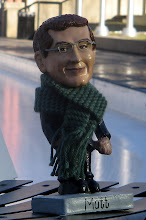Before the National Arts Centre Orchestra's tour date in Calgary last Friday, bassist Joel Quarrington gave a master class at the University of Calgary School of Music. Three young bassists played for Joel: two of Charles Garrett's students at the U of C, and a 13-year-old student of Sheila Garrett.
Joel's approach to teaching, like his playing, is irreverent, inventive, and joyful. After the first student played the first movement of Hindemith's Sonata, he suggested that maybe she could have more fun with the bow -- a clever way to talk about technique without being pedantic about it. He demonstrated an exercise for starting notes distinctly, playing a scale with 4 notes hooked on each bow, and encouraged the student to play it with a solid core sound without pressing. Joel had his own bass there, a 17th-century Maggini, and the student's sound production seemed to improve just from hearing him play a few notes.
Since Joel plays German bow on a bass tuned in 5ths, it wasn't always easy to imitate his playing. He was very accomodating to the players' individual preferences, though, and tried to adjust his own technique to better match what they were trying to do. "Excuse my French bow," he said after playing some fast off-string strokes. He showed the first student, who was sitting on a high stool, how she could better access the upper register of the instrument, by sliding back on her stool and getting more weight over the fingerboard -- Joel's physique is completely different from hers, but she still seemed to find some benefit from the adjustment.
The second student was the 13-year-old, playing the first movement of the Dragonetti Concerto. Joel got him working on fast, fluid shifts and demonstrated the infamous shifting drill - I learned it as "vomit" - to improve accuracy. This raised some set-up issues again, and Joel discussed why his own preference is to sit on a stool for solo performances, while still showing the student how he could manage the shift better while standing.
With all three students, Joel emphasized the need for consistent scale and bowing studies. At one point, he noticed a stack of papers in a bookcase nearby -- the master class was held in a crowded little violin teaching studio room -- and found a sheet with various bowings attached, "like a ransom note" he said. He encouraged everyone to get a set of bowing variations like that one -- whether from an abandoned violin studio, or an actual bowing method -- and work on producing a quality sound with all sorts of articulations.
The last student played the first movement of Bottesini's 2nd concerto very impressively. Joel asked her if she had any issues she wanted to bring up -- she talked about off-string strokes, which again brought up scales and bowing variations. Joel helped her clean up the end of the cadenza, a dizzying whir of 16th notes.
Friday, November 14, 2008
Subscribe to:
Post Comments (Atom)


 Technorati Link Count: no. of blog reactions to this post
Technorati Link Count: no. of blog reactions to this post
No comments:
Post a Comment